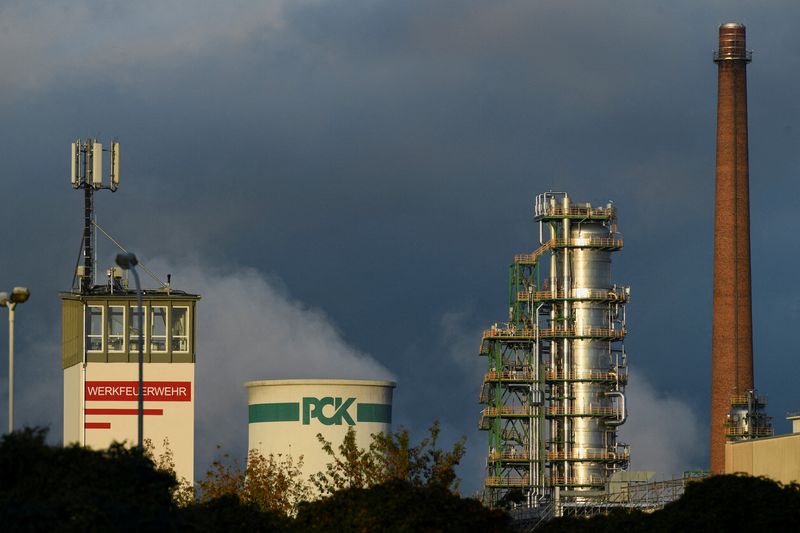Commodities
Analysis-Europe, Africa oil markets tighten, lending support to futures


© Reuters. FILE PHOTO: A view shows oil processing facilities of an PCK oil refinery in Schwedt, Germany October 1, 2022. REUTERS/Annegret Hilse/File Photo
By Alex Lawler, Natalie Grover and Noah Browning
LONDON (Reuters) – Red Sea shipping delays and OPEC+ supply cuts are tightening physical oil markets in Europe and Africa as well as the market structure, lending further support to oil futures prices, according to traders, LSEG data and analysts.
A sustained rise in crude prices would lift energy, transportation and manufacturing costs and threaten to unwind some of the recent falls in global inflation, just as major central banks are expected to begin cutting interest rates.
On Thursday, the benchmark Brent crude futures market structure hit its most bullish since October. The premium of the first-month contract to the six-month contract reached $4.34 a barrel. This structure, called backwardation, indicates a perception of tight prompt supply.
“It looks like there has been a pick-up in (tanker) diversions, which is making the crude balance tighter,” said FGE analyst James Davis. Crude demand is high because of strong refining margins, despite refinery maintenance, he added.
More tankers are avoiding the Red Sea since Yemen’s Houthis began drone and missile attacks against shipping in mid-November, saying they are acting in solidarity with Palestinians as Israel wages war on Hamas.
January average refining margins for diesel and gasoline in Europe rose to multi-month highs of $34.3 and $11.6 a barrel, respectively, Reuters calculations show.
is also in backwardation, with the strength of Brent and WTI taking the trading community by surprise after predictions that supply would outpace demand at the start of the year.
The stronger market is a bonus for the Organization of the Petroleum Exporting Countries and its allies, known as OPEC+. The group has been cutting supply for the past two years but has often struggled to achieve prices above $80 per barrel – the minimum most producers need to balance their budgets.
Brent traded at almost $84 a barrel on Thursday and has risen 9% this year.
OPEC+ leaders have said backwardation is a positive market trend because it discourages traders from holding inventory to resell at a premium later, with low stocks also creating bullish market sentiment.
The world’s onshore crude inventories sit at 4.4 billion barrels, their lowest level since the start of 2017 when intelligence firm Kpler began tracking the data, JPMorgan said in a report.
“The physical sweet crude market is very tight,” said Black Gold Investors CEO Gary Ross, using a term for low-sulphur crude. Libyan outages, a U.S. cold snap that cut output and payment issues for some Russian supplies are among the reasons, he said.
‘FIRMER FOOTING’
OPEC+ sources have said the group will decide in early March whether to extend oil-output cuts into the second quarter of the year or begin returning supply to the market.
“The market has found a firmer footing with Brent trading above $80 for a while now, supported by what looks like a better-than-expected demand outlook together with the…tanker diversions keeping millions of barrels at sea for longer,” said Ole Hansen, Saxo Bank’s head of commodity strategy.
“OPEC+ I’m sure will be very pleased.”
In the North Sea crude market, the differential of Forties crude to benchmark dated Brent has reached the highest since late November and the prices of some other grades considered local alternatives to Middle East crude have soared.
In October, about 1.07 million bpd of Middle Eastern crude came to Europe, Kpler data showed, with volumes falling in the following months amid the Red Sea attacks and expected to average about 606,000 bpd in February.
“Delays to shipments from East of Suez…are making crude closer to home more attractive,” a European crude trader said. “The offers for West Africa and North Sea crude reflect that.”
“Refining margins in Europe for Angolan crude are very favourable and Nigeria is selling cargoes faster than it has for months.”
Nigerian Forcados crude was offered this week at dated Brent plus $6.00 a barrel, the highest since October LSEG data showed. Nigerian grades Qua Iboe and Bonny Light have firmed to dated plus $3.80 and $3.00, respectively.
In Asia, Middle East cash crude differentials have stayed pretty stable month on month, suggesting Europe and African crude is seeing the bulk of the strength.
U.S. crude has been mixed. On the light side, there has been some tightness due to a cold snap last month hitting Permian production, while March loadings to Asia are set to pick up after a weak January and February.
An unplanned outage at BP (NYSE:)’s Whiting refinery has pushed some heavy Canadian crude into the Cushing storage hub and so there is currently little tightness.
Commodities
Oil prices rise; U.S. crude inventories plunge, Russia-Ukraine truce eyed
Commodities
India’s Reliance to stop buying Venezuelan oil over US tariffs, sources say
Commodities
Oil prices climb on Venezuela supply worries

 Forex3 years ago
Forex3 years agoForex Today: the dollar is gaining strength amid gloomy sentiment at the start of the Fed’s week

 Forex3 years ago
Forex3 years agoUnbiased review of Pocket Option broker

 Forex3 years ago
Forex3 years agoDollar to pound sterling exchange rate today: Pound plummeted to its lowest since 1985

 Forex3 years ago
Forex3 years agoHow is the Australian dollar doing today?

 Cryptocurrency3 years ago
Cryptocurrency3 years agoWhat happened in the crypto market – current events today

 World3 years ago
World3 years agoWhy are modern video games an art form?

 Commodities3 years ago
Commodities3 years agoCopper continues to fall in price on expectations of lower demand in China

 Economy3 years ago
Economy3 years agoCrude oil tankers double in price due to EU anti-Russian sanctions



























